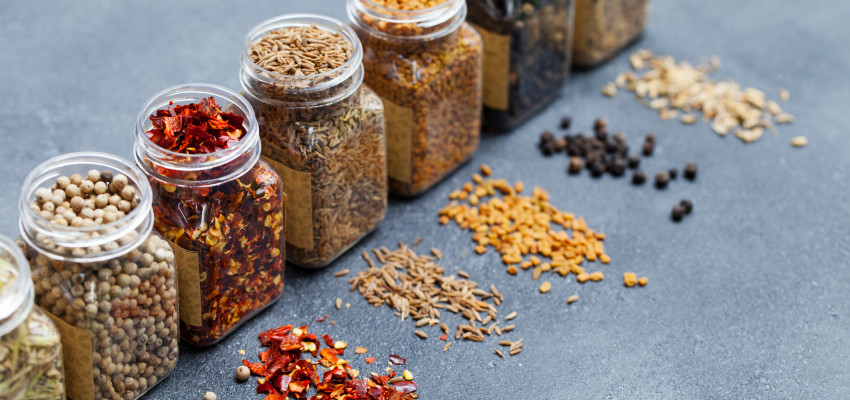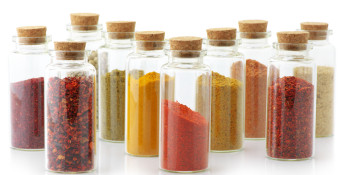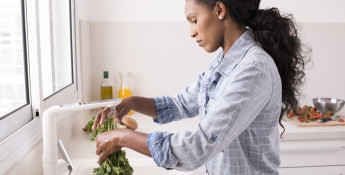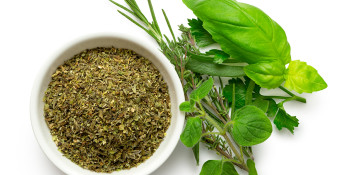By Chef Alli on October 27, 2020
Cooking with Spices

Cooking with spices is essential because they pack a tremendous aromatic punch into our recipes. Spices take dishes from good to great, making a significant and delicious difference in our eating experience.
It’s also important to remember of all the ingredients within a recipe, spices offer the most bang for our buck in terms of flavor. Spices should never be seen as an afterthought in our cooking (or our budget) since their impact can entirely change the way a dish tastes.
Because quality spices are expensive and vital to the cooking process, knowing how to purchase, organize, store and utilize spices in our recipes and cooking is crucial.
What are spices?
Spices come from the buds, bark, seeds or stems of various plants or trees. Spices are used in their dried form and can be found whole (such as nutmeg, peppercorns, cinnamon sticks, etc), in ground form or as leaves.
How should spices be stored?
To help spices last longer, it’s important to keep them away from air, heat and sunlight. I store my spices in a cupboard that’s a few feet from my cooktop where they are handy and protected, yet not directly in close contact to heat and steam.
How are spices best organized?
Some cooks opt to organize their spices between “sweet” or “savory” cooking, but I prefer to keep my spices on two large lazy Susans, organized in alphabetical order. For instance, one lazy Susan holds spices that begin with A-G and the second one holds spices that begin with H-Z.
The spices I use most often are on the outer edge of the lazy Susan for good visibility, while the ones I don’t use as frequently are towards the center, yet still very handy.
Because I use spices in nearly every dish I prepare, I’ve found the alphabetical lazy Susan system to be extremely quick and easy for storing and locating just what I need. (And we all know that if we have to dig through the cupboard to locate something, we have a strong tendency NOT to do it.)
How long do spices last?
This is the 64-million-dollar question, and everyone seems to hold a different opinion.
I always rely on my nose. If the aroma isn’t nice and fragrant immediately upon opening the spice container, out it goes.
I have spices in my cupboard that have been there for two to three years and this does not concern me as long as they still hold a vibrant aroma. In addition, I always employ the power of “blooming” my spices right at the beginning of the cooking process whenever possible. (Learn more about the technique and benefit of blooming spices below.)
Remember this as the main rule of thumb for spice freshness: Good quality spices should tickle and tantalize our senses.
Should spices be stored in specific containers?
Because my spices are stored in a cool dark cupboard, I prefer to use narrow cylinder-type clear glass jars with lids. This way, I can fit more jars into my organizing system.
I do add a label for identification purposes (and for other novice cooks in my home, such as my husband and sons), but the clear glass allows me to quickly recognize the spices by sight, as well.
Where should I purchase spices?
Buy from reputable suppliers. Price is a reliable indicator of quality – we get what we pay for, just as with nearly anything else. If we are purchasing spices at bargain-basement prices, we may be purchasing spices that have lots of added fillers.
I have found ethnic stores to be great sources for fresh spices. Especially those stores that have a good customer base since this is a strong indicator they have a good turnover in their inventory and means their offering of spices is fresh and aromatic.
How should I purchase spices?
Because spices lose their complexity of flavor the longer they sit, it’s often better to purchase them in smaller quantities. The amount of spices we purchase at one time completely depends on how often and how much we cook.
Should I purchase spices in bulk?
Purchasing spices in bulk can offer a great cost savings. However, sometimes (though not always) there is a minimum quantity purchase requirement, such as one pound.
You may be astonished how a pound of oregano leaves doesn’t seem like much until it arrives and you realize you could make Italian cuisine every single day for the rest of your life and not make a dent in it.
I like ordering bulk spices to share with a group of fellow cooks. This way we can manage the bulk amounts by dividing them between us. We get the savings and super fresh spices.
Should spices be added to dishes at a certain time?
As a general rule of thumb, I like to add spices at the very beginning of the cooking process, allowing the heat to intensify them. As an example, when I’m making chili, I add the chili powder to the pot (over medium heat, never high heat) as the very first ingredient, instead of the ground beef or the onions, etc. Adding the spices to the heat source first allows them to bloom, helping to intensify them, most especially if the spices have been in your cabinet a bit longer than they should.
Fresh herbs, on the other hand, should be added at the very end of the cooking process since their power is diminished when too much heat is encountered for too long. (Adding fresh herbs at the beginning of the cooking process completely depletes them of both color and flavor.)
What is spice blooming and how do I do it?
The cooking technique called “blooming” is very worthwhile, and within seconds the flavor and aroma of your spices are amplified and much more powerful.
Blooming should be done at the very beginning of our recipe; this quick process uses heat to cause the essence (oils) of the spices to be released, which immediately magnifies the flavor.
As an example, if you are making a big pot of chili, as mentioned above, instead of first cooking the onions and ground beef as is typical, place the chili powder into your empty pot over medium heat. Within just a few seconds, the wonderful aroma of the spices will waft, signaling to our senses that our spices are now fully bloomed and rejuvenated. Next step? Add the onions and ground beef to the spices and continue with your chili recipe.
Some cooks choose to bloom their spices in a bit of oil at the beginning of their recipe, but oil is not a requirement. Spices can be bloomed in a dry skillet or pot as long as you keep a watchful eye since their oils can quickly scorch, causing a bitter taste.
I like to place my spices into my empty cooking vessel over medium to medium-low heat, giving them a few quick stirs to keep them from scorching. Once I smell the delicious aroma of the spices, I know they have bloomed and I can either set my pot aside for later or continue on with my recipe.
Can I make my own spice rubs, seasonings and blends?
Absolutely! It’s fun to make unique seasonings and spice blends, based on our own taste buds. Combine your favorite spices for a customized rub or seasoning blend. Create your own concoction of mulling spices, pumpkin pie spice or even a steak seasoning. The sky is the limit. These blends also make great gifts for fellow cooks in our lives. Include a recipe in which the spice blend is included, and they will be even more delighted.
Are salt and pepper spices?
Because salt and pepper are so common, we often fail to remember they, too, are very important spices.
There are many forms of kosher salt and sea salt, each one with their own unique power and flavor. I prefer using plain kosher salt for my recipes since it’s easy to grab a pinch or two of those big flakes with my fingertips when needed.
As for pepper, I am a big believer of freshly ground black pepper instead of pre-ground pepper from a shaker. Like all dried spices, pepper begins to lose its potency as soon as we grind it. Grinding it fresh by hand right at the time it’s needed means the pepper will have more flavor as well as some added crunchy texture.
Do I need tools for cooking with spices?
Some cooks prefer to cook with whole spices since grinding them fresh at the time of use yields the most heightened flavors.
I have found two handy tools for grinding whole spices - a mortar and pestle and an electric coffee grinder. The mortar and pestle works great for small amounts of spices, while a coffee grinder is very efficient and quick if you need to grind larger quantities.
Another great tool for cooking with whole spices is a rounded spice grater. I love to use freshly grated nutmeg and have found this tool to be the easiest way to quickly grate whole nutmeg.




